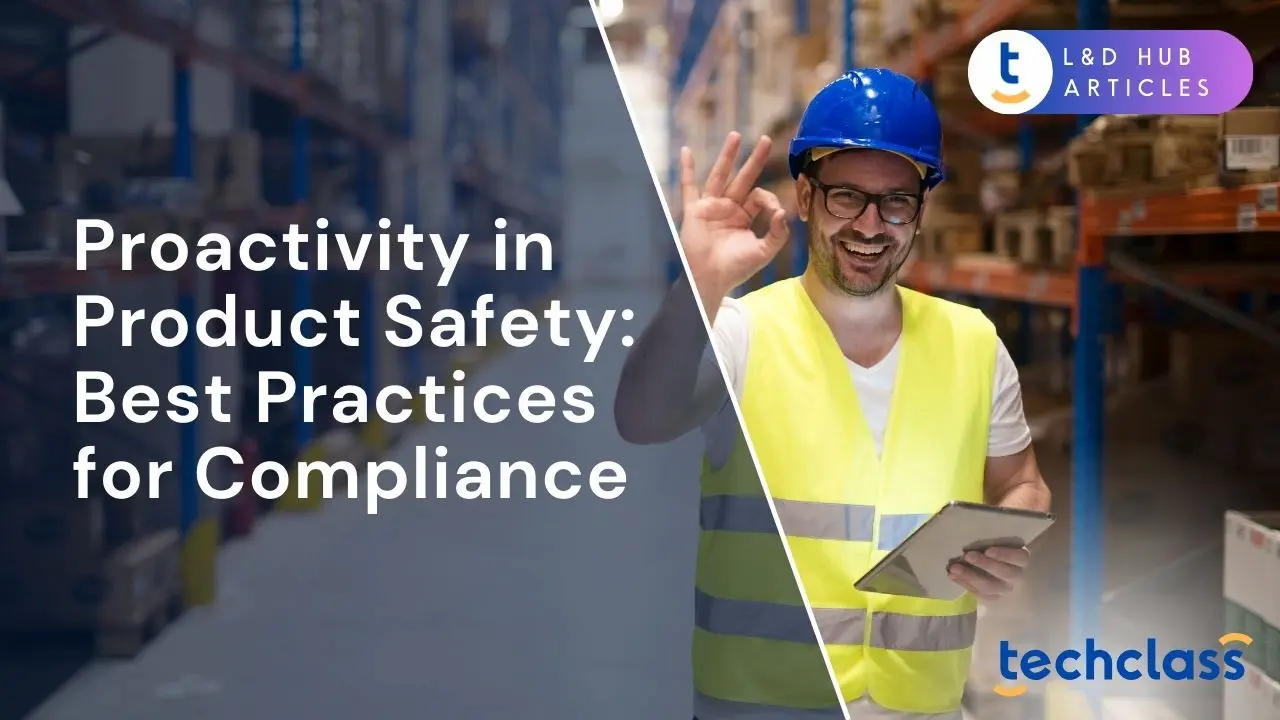
Product safety has become a board-level concern in today’s business environment. Regulatory bodies worldwide are intensifying oversight, issuing more recalls and penalties than ever. In the U.S., consumer product incidents now cost over $1 trillion annually in injuries, deaths, and property damage. In fact, 2024 saw a five-year high in recalls, 909 recalls in a single quarter across major industries. Such figures underscore that ensuring product safety is not just an ethical responsibility but a financial imperative. Companies that take a reactive approach—addressing safety issues only after accidents or violations occur—face enormous risks. By contrast, a proactive approach to product safety compliance can prevent tragedies, protect customers, and safeguard the organization’s reputation and bottom line. This article explores how HR professionals, CISOs, business owners, and enterprise leaders across industries can foster a culture of safety and implement best practices to stay ahead of product safety regulations.
Heightened regulatory scrutiny has dramatically raised the stakes for product manufacturers and distributors. Agencies like the U.S. Consumer Product Safety Commission (CPSC) have adopted an aggressive enforcement posture. Civil penalties for safety violations are skyrocketing, in fiscal 2023, CPSC fines topped $52 million, a 64% increase over the previous year. Regulators are willing to make high-profile examples of companies that fall short. For instance, fitness equipment maker Peloton was hit with a $19 million penalty for failing to report a defect in its treadmills that tragically caused a child’s death. Retailers have not been spared either: in one case, a retailer paid $9 million for not reporting a fire hazard in products it sold. These examples send a clear message, non-compliance can swiftly trigger multi-million dollar fines, legal action, and criminal investigations. Enterprise leaders must recognize that regulators today have both the will and the tools to hold businesses accountable for product safety lapses.
Beyond regulatory sanctions, the cost of product safety failures can be devastating in other ways. Product recalls, lawsuits, and damage to brand trust carry long-term financial consequences. A stark example is the Takata airbag recall, which affected over 41 million vehicles worldwide and ultimately cost the manufacturer $24 billion, driving the company into bankruptcy. Even less catastrophic recalls can incur massive expenses in notifying customers, repairing or replacing products, and handling legal settlements. Reputational damage may be harder to quantify but is just as severe: consumers and business partners lose confidence in companies associated with unsafe products. In an era of instant communication and social media, news of a safety incident can spread quickly, causing public relations crises that take years to mend. In short, a reactive approach—waiting until injuries occur or regulators intervene—exposes organizations to immense peril. By contrast, investing in proactive safety compliance helps avoid these high stakes altogether, preserving customer trust and the firm’s market standing.
A strong culture of safety is the foundation of any effective product safety program. Leadership must set the tone from the top that product safety and compliance are core values of the organization. This starts with executives and managers visibly prioritizing safety in every decision and communication. Senior leaders should encourage an environment where employees at all levels feel empowered to speak up about potential hazards or quality concerns without fear of retaliation. When workers know that management genuinely cares about safety over short-term profits, they are more likely to report issues early, enabling the company to address problems before they escalate.
Human Resources and training departments play a key role in cultivating this culture. Regular Compliance Training and education programs should ensure that employees understand relevant safety standards and their own responsibilities for compliance. From design engineers and factory floor workers to marketing and customer service teams, everyone should know how their work can impact product safety. Companies can institute safety committees or “safety champions” in each department to keep awareness high. It’s also wise to integrate safety metrics into performance evaluations and recognition programs, for example, rewarding teams for identifying and mitigating risks. The goal is to make safety “everyone’s job.” When employees take pride in making a safe product, they become proactive partners in compliance rather than passive observers.
Open communication is another pillar of a safety-first culture. Firms should establish clear, confidential channels (like hotlines or internal apps) for reporting safety concerns or near-misses. Whistleblower protections are critical so that staff know they will be praised, not punished, for flagging a potential issue. In the United States, such safeguards exist under the Consumer Product Safety Improvement Act (15 U.S.C. § 2087), and in Europe under the EU Whistleblower Protection Directive (2019/1937), which both protect individuals who report safety or regulatory breaches.
Some companies conduct regular safety climate surveys to gauge whether the culture truly empowers reporting. By acting on employee feedback and incident reports, management demonstrates its commitment. According to the CPSC, maintaining a strong safety culture that emphasizes product safety and compliance is critically important for companies striving to go “above and beyond” basic requirements. In practical terms, this means continually asking: Are we doing enough to make our products as safe as possible? The most safety-forward organizations constantly challenge themselves and seek improvements, rather than settling for mere compliance. Cultivating this mindset across the workforce builds the human infrastructure needed for sustainable product safety outcomes.
While culture provides the values, a formal Product Safety Compliance Program (PSCP) supplies the framework and processes to put those values into action. A PSCP is essentially a structured set of policies and procedures to ensure products meet all applicable safety regulations and standards. This program should be cross-functional, involving teams from product design, engineering, quality assurance, supply chain, legal, and even IT/security (for connected products). By establishing a dedicated compliance program, companies move from ad-hoc or siloed efforts to a coordinated, proactive strategy. Here are key components and best practices typically included in an effective PSCP:
By implementing a robust PSCP with the elements above, companies transition from simply reacting to problems to actively preventing them. A well-designed compliance program will encompass everything from initial design controls to final market surveillance. In essence, it operationalizes the mantra that product safety is an ongoing process, not a one-time project. Businesses that excel in this area often find that compliance is not just about avoiding penalties, it drives better quality products overall and can even become a selling point to customers who value safety.
Launching a compliance program is not a one-and-done effort; maintaining product safety requires continuous vigilance and adaptation. Leading organizations establish mechanisms for ongoing monitoring, review, and improvement of their product safety processes. One aspect of this is regularly auditing your own operations. Internal compliance audits (and occasional third-party audits) should be conducted to verify that procedures are being followed on the factory floor, in design labs, and across the supply chain. When audits or inspections uncover gaps, treat them as opportunities to strengthen your program. In recent years, over half of manufacturers reported significant compliance issues during audits, highlighting that constant monitoring is needed to catch issues that routine processes might miss. By proactively auditing and correcting course, you can fix small problems before they become major safety incidents.
Another powerful tool is data analytics and feedback loops. Companies now collect vast data on product performance, from IoT sensors, warranty claims, customer reviews, and returns. Analyzing this data can reveal early warning signs of safety issues. For example, a spike in customer complaints about overheating devices or an unusual pattern of part failures could indicate a latent hazard. By tracking such trends, safety teams can investigate and intervene sooner. As one best practice, some firms have established cross-departmental reviews of incident data (including minor issues and “near-miss” events) on a monthly or quarterly basis. These reviews generate actionable insights: perhaps a design needs tweaking, a manufacturing step needs reinforcement, or users need clearer instructions. Continuous improvement means feeding lessons learned back into design and production, creating a virtuous cycle of safer products. Over time, this iterative approach can dramatically reduce defect rates and safety incidents, as the organization learns from past mistakes. Indeed, companies that embrace a data-driven, learning-oriented mindset toward compliance stay ahead of those that set and forget their safety protocols.
Staying ahead also requires looking outward. Regulatory requirements and industry standards are always evolving, and proactive companies monitor these changes closely. Enterprise leaders should ensure someone on the team (or an external consultant) is tasked with scanning the horizon for new or upcoming regulations that could affect the product line. For example, the European Union’s new General Product Safety Regulation (GPSR) coming into effect in 2024 introduces stricter requirements for consumer goods, and new standards around emerging risks (such as cybersecurity for IoT devices) are being codified. A recent example in the tech realm is the push for “secure by design” requirements, the EU’s Cyber Resilience Act will mandate cybersecurity features in many products, effectively treating digital vulnerabilities as safety issues. A CISO or product security officer should be involved to ensure compliance with such security-related product standards. By tracking proposals, attending industry compliance workshops, and participating in trade associations, companies can anticipate regulatory shifts. This allows you to adjust designs or compliance procedures well before new rules hit. It also provides an opportunity to engage with regulators early, for instance, giving feedback during rulemaking or aligning internal standards with likely future requirements. In short, proactivity in compliance means not only meeting today’s rules but preparing for tomorrow’s. Organizations that stay ahead of the curve gain a competitive edge, as they are rarely caught off-guard by new safety expectations.
No matter how diligent a company is, there is always a possibility that an unsafe product could slip through or a hazard might emerge post-launch. That’s why being prepared for recalls and incidents is an integral part of proactive product safety management. The speed and effectiveness of your response can make a tremendous difference in outcomes for consumers and for your business. Experts and regulators alike emphasize that one of the best ways to ensure an effective recall is to have a detailed recall plan in place before it’s needed. A well-thought-out recall plan should spell out the step-by-step actions the company will take if a product needs to be withdrawn from the market. This includes clear roles and responsibilities (Who notifies regulatory authorities? Who manages press communications? How will customers be contacted and remediation provided?), as well as up-to-date contact lists and template communications ready to go.
An effective recall plan also addresses logistical challenges: How will you trace which batches or serial numbers are affected? Do you have the capability to contact all customers (e.g. via registration databases or sales records)? Planning these details in advance can save precious time during a real crisis. Time is of the essence, acting quickly can prevent further injuries and demonstrates good faith to regulators and the public. The CPSC notes that a prompt, well-executed recall “can save lives, prevent injuries, and limit damage to your company’s brand and bottom line.” In other words, doing recalls right is part of being proactive; it turns a potential disaster into a manageable event. Companies that respond sluggishly or uncooperatively, on the other hand, face harsher penalties and greater public backlash for appearing negligent.
Communication is a critical element of recall response. Be transparent and comprehensive in notifying consumers about the issue and what they should do. Use multiple channels, press releases, social media, retailer notifications, direct customer outreach, to maximize reach. It’s often wise to provide a dedicated web page or hotline for the recall so customers can easily get information and assistance (such as how to return or repair the product). Internally, ensure customer service teams are well briefed to handle inquiries with empathy and clarity. If the issue is serious, engaging an experienced crisis communication firm might be beneficial to manage messaging. Additionally, coordinate closely with regulators during the recall process; their guidance can help ensure all legal requirements are met and that the public perceives the recall as responsible and credible.
After navigating a recall or safety incident, conduct a post-mortem analysis. What went wrong with the product or process that allowed the issue? How effective was our response, and what can we improve next time? Feed these lessons back into the product safety compliance program. Some companies emerge from recalls with even stronger processes, for example, they might implement new testing steps, enhance supplier audits, or improve tracking of customer purchases for faster notification. While the goal is to avoid recalls entirely, being ready for the worst-case scenario is a hallmark of proactive safety management. It reassures regulators that your company is responsible and can significantly reduce the long-term fallout. In sum, recall preparedness is like an insurance policy: you hope never to use it, but having it can be lifesaving for consumers and business-saving for the company.
Proactive product safety compliance is often viewed as a cost or a burden, but in truth it can become a competitive advantage and a cornerstone of corporate integrity. By embedding safety and compliance into the DNA of the organization, companies protect their customers, the very people whose trust and loyalty determine long-term success. They also protect their own employees and stakeholders from the turmoil that accompanies product crises. In an age of instant information, customers are increasingly aware of and concerned about product safety. Businesses known for stringent safety standards and transparency earn a reputation for trustworthiness, which can differentiate them in the market. Just as importantly, a proactive stance on safety and compliance fosters innovation: teams are encouraged to solve problems and design better, safer products, rather than cutting corners.
For enterprise leaders, including HR professionals and CISOs, championing product safety is an opportunity to demonstrate ethical leadership and prudent risk management. It aligns with broader governance goals and ESG (environmental, social, governance) commitments that many organizations strive to meet. When done right, compliance is not merely about avoiding fines or legal issues, it is about building a brand that people can rely on. As we have discussed, the best practices, from cultivating a safety-first culture, to implementing robust compliance programs, to continuously learning and adapting, all contribute to a resilient organization. Such an organization is far less likely to be blindsided by safety problems, and more likely to excel even under regulatory scrutiny.
Ultimately, being proactive in product safety is about taking care of people. Products are integrated into every facet of our lives, and ensuring those products do no harm is a fundamental responsibility of any business. By taking that responsibility seriously, companies not only avert disasters but also create positive outcomes: happier customers, a motivated workforce, and confidence among regulators and partners. The journey to proactive compliance is ongoing, but it is one well worth taking. It transforms compliance from a checkbox exercise into a driver of quality and trust. In the long run, organizations that lead on safety will find that compliance isn’t just about following rules, it’s about leading the market in values and excellence.
Proactive product safety compliance is the practice of preventing safety issues before they occur by embedding safety measures into every stage of a product’s lifecycle—from design and manufacturing to supply chain and post-market monitoring—rather than reacting only after problems arise.
A safety-first culture ensures that all employees prioritize product safety in their daily work. It empowers staff to report hazards without fear, integrates safety into decision-making, and fosters shared accountability across the organization, making compliance more effective and sustainable.
A PSCP typically includes understanding regulatory requirements, safety-by-design principles, rigorous quality control, thorough documentation and traceability, strong supplier management, ongoing employee training, and clear accountability through dedicated compliance teams.
Businesses can stay ahead by continuously monitoring regulatory changes, engaging in industry forums, attending compliance workshops, and involving experts like CISOs for security-related product standards. Proactive adjustments to designs and processes help ensure readiness before new rules take effect.
Even the most diligent companies may face unexpected safety issues. Having a recall plan in place—covering roles, communication channels, and tracing capabilities—allows for quick, effective responses that protect consumers, satisfy regulators, and minimize brand damage.
.webp)

